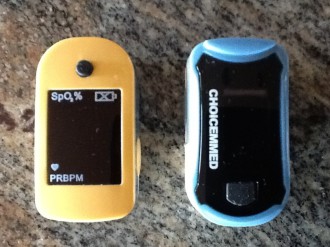I own a pulse oximeter and have found it quite helpful over the years. A pulse oximeter is a device used to measure blood oxygen saturation and pulse rate. They are very inexpensive and can be found at many pharmacies, and online. They can be used in multiple situations and are beneficial if you or someone you care for is using oxygen therapy. They can be valuable in monitoring bronchitis, pneumonia, asthma and other respiratory conditions. If can also be helpful in monitoring the body’s reaction to increased physical activities and exercise. Since it provides readings in seconds you can quickly check to see if you are at your target heart rate while exercising.
What is Pulse Oximetry?
Pulse oximetry measures the amount of oxygen carried by your red blood cells. Hemoglobin carries the oxygen molecules from the lungs through the body. The oxygen depleted blood returns to the heart and lungs through the veins. Pulse oximetry measures the percentage of oxygen being carried through the arteries compared with maximum levels. Oxygen saturation is an important reading for people with lung conditions and other disorders who need supplemental oxygen.
How does it Work?
A fingertip pulse oximeter shines red and infrared light through the finger and detects fluctuating signals caused by blood flow. Blood absorbs light differently depending on the level of oxygen it contains; oxygenated hemoglobin absorbs infrared light and allows red light to pass through, where deoxygenated blood is the opposite, absorbing red light and allowing infrared light to pass through. When you put a pulse oximeter on your finger, the light passes through the finger and on to a photo detector on the other side. The photo detector calculates the ratio of red to infrared light. The ratio is then compared against a table that is unique to each oximeter, which then shows the oxygen saturation level or Sp02 reading, as well as your heart rate.
The Sp02 reading shows what percentage of your hemoglobin molecules are carrying oxygen-your blood oxygen saturation. A Sp02 reading of 94 tells you that 94% percent of your hemoglobin molecules are carrying oxygen.
Problems with a Pulse Oximeter
Having cold hands and fingers can result in inaccurate readings or no reading at all.
Poor positioning of the oximeter can be a problem with very small or very large fingers.
Wearing nail polish can cause inaccurate readings.
References:
Moyle JTB (2002) Pulse Oximetry 2nd ed. BMJ books, London (BMJ books)
Howell M (2002) Pulse oximetry: an audit of nursing and medical staff understanding British Journal of Nursing 11(3): 191-7 Pubmed








